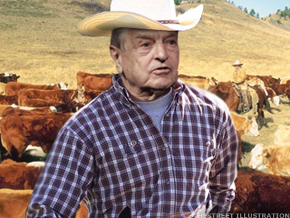It's a waste because half the sites linking to the reports don't understand what the SEC requires and the various ways the funds can reduce transparancy.
I'll leave that discussion to another post. Another problem is that most of the commenters are clueless when it comes to connecting investments listed in the reports to major economic and financial trends. When Soros Fund Management LLC released their positions a couple weeks ago most of the commentariat glommed onto the funds drastic reduction in the SPDR gold trust. There were maybe two dozen comments that pointed out the new names in the portfolio. There were a handful who made the connection between SFM's new largest position and the current commodity megatrend.
Back on April Fools Day we posted: "Farmland: "Investors pump $400m into Ukraine farming groups"; Soros-Backed Adecoagro Trades solidly Above IPO Price Despite Loss (AGRO)" as part of our almost obsessive attraction to farmland as an investment (links below).
Here's SFM's March 31, 2011 13F. At the bottom of the page we find Adecoagro, 27,158,693 shares worth $366,099,000. That is the fund's largest position, the second biggest being $302 mil. worth of InterOil (use the blog search box, symbol IOC, we have quite a few posts) and the SPDR S&P 500 ETF worth $278 mil.
It was also a new position.
Mr. Soros' has had an interest in Adecoagro through other entities for some time but for SFM it was brand new.
You'd think that Soros buying farmland as his largest position would have made headlines around the world.
It didn't.
One writer who did understand, Frank Byrt at TheStreet, put this story together:
5 Stocks to Bet on Farming, Like Soros Does
Billionaire investor George Soros has gone from gold bug to gaucho, as his hedge fund took a 23% stake in a South American farming conglomerate after dumping most gold holdings in the first quarter.I'll come back to AGRO later this week. In the meantime here are some of the stories we thought were signposts along the way:
Soros' move underscores a growing trend among investors who are cutting back on gold and shifting into assets that can produce saleable products, such as farmland, and hence serve as an inflation hedge as well as a bet on the value of the land.
South America is the geographic hotspot for many of these companies due to its favorable growing climate, dearth of natural disasters, the availability of farmland and a minimal number of government restrictions on its ownership by foreigners.
And many companies there grow can grow sugar and corn which then have multiple uses for them depending on market conditions, either as human food, animal feed or to be converted into bio-fuels.
Other hedge funds recently joining Soros down on the farm are the $18.7 billion Van Eck Associates fund, which is the largest investor in Brasil Foods(BRFS), with a 1% stake, and D.E. Shaw & Co., which is the largest shareholder of Argentine farm conglomerate Cresud(CRESY) at just under 9% of its shares, according to Securities and Exchange Commission 13-F filings.
Renatto Barbieri, chief investment officer at Galtere Ltd., a New York-based private-equity firm that, among its many investments, runs a $1 billion agribusiness fund, said in an interview that "there is a global trend to be invested in, what we would call 'real assets,' and tangible assets in agriculture is very much a part of that basket."
He said that's being driven by concerns over "climate change, food (supply) security and the health of the financial system....MORE
2007
Ethanol Is Feeding Hot Market for Farmland
2008
Farmland value boom continues
The hedge fund manager who bought a farm
Hedge Funds Buying Farmland
England's green and pricey land
Did Hedge Funds Signal the Top in Farm Income?
Californians to pay $600 mln for green think tank. And Farm visits can ease mental illness
As I said, more to come on AGRO.
And more of our earlier posts on farmland investments.
Or you can copy and paste " site:climateerinvest.blogspot.com climateer farmland" as a search term.
